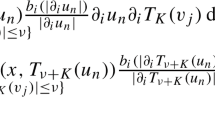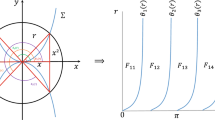Abstract
In this paper, we are concerned with the analysis of two-transistor circuits. Applying technique for the numerical verification, we prove rigorously the existence of five solutions in a two-transistor circuit. The system of equations for a transistor circuit is obtained as nonlinear equations, therefore Krawczyk’s method is applied for proving the existence of a solution.
Similar content being viewed by others
References
L. Kronenberg, L. Trajkovic and W. Mathis, Finding dc operating points: Limitations of topological and determinant criteria. Proc. of International Symposium on Nonlinear Theory and Its Applications (NOLTA 2000), Dresden, Germany, 2000, 209–212.
L. Kronenberg, L. Trajkovic and W. Mathis, Analysis of feedback structures and effect on multiple dc operating points. European Circuit Theory and Design Conference, Stresa, Italy, 1999, 683–686.
L. Kronenberg, W. Mathis and L. Trajkovic, Limitations of criteria for testing transistor circuits for multiple dc operating points. Proc. 43rd Midwest Symposium on Circuits and Systems (MWSCAS 2000), Lansing, MI, 2000, 1156–1159.
B.G. Lee and A.N. Willson, Number of dc solutions of two-transistor circuits containing feedback structures. Dissertation, Los Angeles, CA: Univ. of Calif., Los Angeles, El. Eng. Dept., 1982.
B.G. Lee and A.N. Willson, All two-transistor circuits possess at most three dc operating equilibrium points. Proc. 26th Midwest Symp. Circuits and Systems, Puebla, Mexico, 1983, 504–507.
L.B. Goldgeisser and M.M. Green, Some two-transistor circuits possess more than three operation points. Proc. IEEE International Symposium on Circuits and Systems, 1999, 1002–1006.
X. Shou, L.B. Goldgeisser and M.M. Green, A methodology for constructing two-transistor multistable circuits. Proc. IEEE International Symposium on Circuits and Systems, 2001, 377–380.
M. Claus, Geometrical analysis of two-transistor circuits with more than three operating points. Proc. of European Conference on Circuit Theory and Design (ECCTD 2005), 2005.
R. Nielsen and A.N. Willson, A fundamental result concerning the topology of transistor circuits with multiple equilibria. Proc. IEEE,68 (1980), 196–208.
T. Nishi and L.O. Chua, Topological criteria for nonlinear resistive circuits containing controlled sources to have a unique solution. IEEE Trans. on Circuits and Systems,CAS-31 (1984), 722–741.
M. Fosseprez, M. Hasler and C. Schnetzer, On the number of solutions of piecewise linear resistive circuits. IEEE Trans. Circuits and Systems,36 (1989), 393–402.
T. Nishi and Y. Kawane, On the number of solutions of nonlinear resistove circuits. IEICE Trans. on Fundamentals,E74 (1991).
T, Nishi, A transistor circuit can possess infinitely many solutions under the assumption that the first and the second derivatives of thev-i curves of nonlinear resistors are positive. Proc. ISCAS ’96, Atlanta, 1996.
Y. Jitsumatsu and T. Nishi, Maximum number of solutions for a kind of nonlinear simultaneous equations with two variables. IEICE Transactions on Fundamentals,82-A (1999), 1175–1176 (in Japanese).
Y. Jitsumatsu and T. Nishi, On the number of solutions for a class of piecewise-linear equations related to transistor circuits. IEICE Trans. on Fundamentals,E84-A (2001), 2221–2229.
ANSI/IEEE 754-1985, Standard for Binary Floating-Point Arighmetic. 1985.
R. Krawczyk, Newton-Algorithm zur Bestimmung von Nullstellen mit Fehleshranken. Computing,4 (1969), 187–201.
R.E. Moore, A test for existence of solutions for non-linear systems. SIAM J. Numerical Analysis,14 (1977), 611–615.
A. Neumaier, Interval methods for systems of equations. Encyclopedia of Mathematics and Its Applications, Cambridge University Press, 1990.
Author information
Authors and Affiliations
Corresponding author
About this article
Cite this article
Nakaya, Y., Nishi, T., Oishi, S. et al. Numerical existence proof of five solutions for certain two-transistor circuit equations. Japan J. Indust. Appl. Math. 26, 327–336 (2009). https://doi.org/10.1007/BF03186538
Received:
Revised:
Issue Date:
DOI: https://doi.org/10.1007/BF03186538




